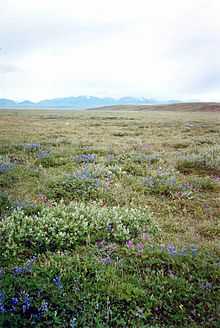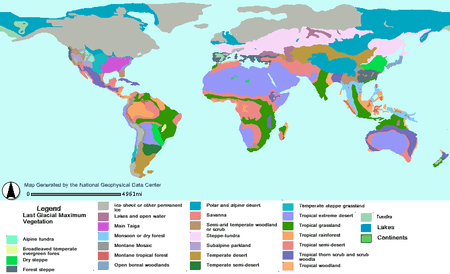Mammoth steppe

Steppe-tundra or mammoth steppe is a very cold dry-climate vegetation type consisting of mostly treeless open herbaceous vegetation. It was widespread during Pleistocene times at mid-latitudes of Eurasia and during some phases in North America.[1]
Tundra
Steppe-tundra can be divided into two types.[1] East of the Urals vegetation was more tundra-like, analogies have been drawn with a treeless vegetation that presently occurs in scattered patches on well drained south-facing hillslopes in north-eastern Siberia, although the modern-day equivalent is thought to have too dense a ground cover of vegetation.[2]
Ground cover amounted to no more than about 50%, with mainly herbaceous plants but a few scattered low shrubs and occasional stunted trees in sheltered spots. Peat accumulation would have been negligible, and the soil would have had a much lower organic content than most present-day tundra such as Ubsunur Hollow.[1] These characteristics are inferred indirectly from knowledge of the habitat preferences of the individual plant species that were present in this vegetation, and from related zoological and sedimentological evidence.[1]
The western end of the steppe-tundra zone covered from southwestern France through northern Germany and the central European plain. At these temperate latitudes intense sunlight and loess soils permitted a high level of bioproductivity; mosses, lichens, grasses, and low shrubs that fed saiga antelope, mammoths, horses, bison, giant deer, aurochs and reindeer.
Human colonisation
Humans colonised the environment west of the Urals, hunting reindeer especially,[3] but were faced with adaptive challenges; winter temperatures averaged from −20 to −30 °C (−4 to −22 °F) while fuel and shelter were scarce. They travelled on foot and relied on hunting highly mobile herds for food. These challenges were overcome through technological innovations: production of tailored clothing from the pelts of fur-bearing animals; construction of shelters with hearths using bones as fuel; and digging of “ice cellars” into the permafrost for storing meat and bones.[3][4]
See also
References
- ↑ 1.0 1.1 1.2 1.3 "Steppe-tundra". Estimates of preanthropogenic carbon storage in global ecosystem types. Oak Ridge National Laboratory. Retrieved 2007-09-04.
- ↑ Khotinsky, N.A. (1984). "Holocene vegetation history". In A.A. Velichko. Late Quaternary Environments of the Soviet Union. London: Longman. pp. 179–200.
- ↑ 3.0 3.1 Hoffecker, J. (2006). A Prehistory of the North: Human Settlements of the Higher Latitudes. New Jersey: Rutgers University Press. p. 101.
- ↑ Hoffecker, John F. (2002). Desolate landscapes: Ice-Age settlement in Eastern Europe. New Brunswick: Rutgers University Press. pp. 158–162, 217–233.
